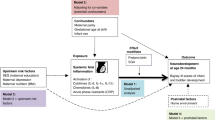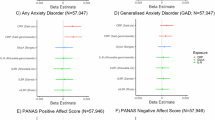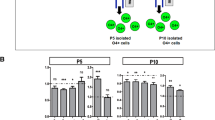Abstract
The pro-inflammatory cytokine IL-6 may be neurocytopathogenic, and elevated levels are associated with impaired neurological outcome among children born prematurely. However, the precise mechanisms underlying this association remain unclear. The rare C (rather than G) variant at position –572 in the IL-6 gene is associated with an increased IL-6 synthetic response. If IL-6 mediates cerebral injury, we would anticipate the –572 C allele to be associated with impaired childhood development. We have examined this hypothesis, studying 113 Caucasian children born at ≤32 wk gestation. Cognitive and motor functions were assessed using the Griffiths Developmental Scales at 2 y and British Ability Scales (2nd Ed.) and the ABC Movement Score at 51/2 y. Performance (median, interquartile range) in all three scales was worse in the 10 carriers of the C allele than for those with GG genotype: Griffiths Developmental Quotient: C allele, 92.4 (89.9–96.6) versus CG 100.9 (96.7–104.8), p = 0.002; General Cognitive Ability: C allele, 88.0 (80.3–102.8) versus GG 103.0 (92.0–112.0), p = 0.037; Movement ABC score: C allele 8.3 (6.6–20.3) versus GG 4.0 (1.0–9.5), p = 0.081. The presence of the rare (≥1) IL-6 -572 C-allele (CC+GC genotypes) is associated with impaired cognitive development among children born before 32 wk gestation. These data support a role for IL-6 in the genesis of neurologic impairment in such children.
Similar content being viewed by others
Log in or create a free account to read this content
Gain free access to this article, as well as selected content from this journal and more on nature.com
or
Abbreviations
- DQ:
-
Griffiths developmental quotient
- GCA:
-
general cognitive ability, British Ability Scales, 2nd Ed.
- WMD:
-
white matter damage
References
Wood NS, Marlow N, Costeloe K, Gibson AT, Wilkinson A 2000 Neurologic and developmental disability after extremely preterm birth. EPICure Study Group. N Engl J Med 343: 378–384
Botting N, Powls A, Cooke RW, Marlow N 1998 Cognitive and educational outcome of very-low-birthweight children in early adolescence. Dev Med Child Neurol 40: 652–660
Saigal S, Hoult LA, Streiner DL, Stroskopf BL, Rosenbaum PL 2000 School difficulties at adolescence in a regional cohort of children who were extremely low birth weight. Pediatrics 105: 325–331
Huddy CL, Johnson A, Hope P 2001 Educational and behavioural problems in babies of 32–35 weeks gestation. Arch Dis Child Fetal Neonatal Ed 85: F23–F28
Ment LR, Vohr B, Allan W, Katz KH, Schneider KC, Westerveld M, Duncan CC, Makuch RW 2003 Change in cognitive function over time in very low-birth-weight infants. JAMA 289: 705–711
Duggan PJ, Maalouf EF, Watts TL, Sullivan MH, Counsell SJ, Allsop J, Al-Nakib L, Rutherford MA, Battin M, Roberts I, Edwards AD 2001 Intrauterine T-cell activation and increased proinflammatory cytokine concentrations in preterm infants with cerebral lesions. Lancet 358: 1699–1700
Fotopoulos S, Pavlou K, Skouteli H, Papassotiriou L, Lipsou N, Xanthou M 2001 Early markers of brain damage in premature low-birth-weight neonates who suffered from marked perinatal asphyxia and/or infection. Biol Neonate 79: 213–218
Martin-Ancel A, Garcia-Alix A, Pascual-Salcedo D, Cabanas F, Valcarce M, Quero J 1997 Interleukin-6 in the cerebrospinal fluid after perinatal asphyxia is related to early and late neurological manifestations. Pediatrics 100: 789–794
Yoon BH, Romero R, Yang SH, Jun JK, Kim IO, Choi JH, Syn HC 1996 Interleukin-6 concentrations in umbilical cord plasma are elevated in neonates with white matter lesions associated with periventricular leukomalacia. Am J Obstet Gynecol 174: 1433–1440
Yoon BH, Jun JK, Romero R, Park KH, Gomex R, Choi JH, Kim IO 1997 Amniotic fluid inflammatory cytokines (interleukin-6, interleukin-1 beta, and tumor necrosis factor-a), neonatal brain white matter lesions and cerebral palsy. Am J Obstet Gynecol 177: 19–26
Marin-Padilla M 1997 Developmental neuropathology and impact of perinatal brain damage. II: white matter lesions of the neocortex. J Neuropathol Exp Neurol 56: 219–235
Inder TE, Huppi PS, Warfield S, Kikinis R, Zientara GP, Barnes PD, Jolesz F, Volpe JJ 1999 Periventricular white matter injury in the premature infant is followed by reduced cerebral cortical gray matter volume at term. Ann Neurol 46: 755–760
Stewart AL, Rifkin L, Amess PN, Kirkbride V, Townsend JP, Miller DH, Lewis SW, Kingsley DP, Moseley IF, Foster O, Murray RM 1999 Brain structure and neurocognitive and behavioural function in adolescents who were born very preterm. Lancet 353: 1653–1657
Brull DJ, Montgomery HE, Sanders J, Dhamrait S, Luong L, Rumley A, Lowe GD, Humphries SE 2001 Interleukin-6 gene –174g>c and –572g>c promoter polymorphisms are strong predictors of interleukin-6 levels after coronary artery bypass surgery. Arterioscler Thromb Vasc Biol 21: 1458–1463
Investigators for the Avon Premature Infant Project 1998 Randomised trial of parental support for families with very preterm children. Arch Dis Child Fetal Neonatal Ed 79: F4–11
Griffiths R 1954 The Abilities of Babies. University of London Press, London, pp 1–213
Elliot CD, Murray DJ, Pearlson LS 1983 The British Ability Scales. NFER-Nelson Publishing, Windsor, 1–321
Henderson SE, Sugden DA 1992 Movement Assessment Battery for Children. The Psychological Corporation, Sidcup Kent, pp 1–290
Levene MI 1981 Measurement of growth of the lateral ventricles in preterm infants with real-time ultrasound. Arch Dis Child 56: 900–904
Dubowitz LM, Bydder GM, Mushin J 1985 Developmental sequence of periventricular leukomalacia. Correlation of ultrasound, clinical and nuclear magnetic resonance functions. Arch Dis Child 60: 349–355
Leviton A, Gilles F 1997 Ventriculomegaly, delayed myelination, white matter hypoplasia and “periventricular” leukomalacia: how are they related?. Pediatr Neurol 15: 127–136
Paneth N 1999 Classifying brain damage in preterm infants. J Pediatr 134: 527–529
Bhutta AT, Cleves MA, Casey PH, Cradock MM, Anand KJ 2002 Cognitive and behavioural outcomes of school-aged children who were born preterm: a meta analysis. JAMA 288: 728–737
Terry CF, Loukaci V, Green FR 2000 Cooperative influence of genetic polymorphisms on interleukin 6 transcriptional regulation. J Biol Chem 275: 18138–18144
Inder TE, Anderson NJ, Spencer C, Wells S, Volpe JJ 2003 White matter injury in the premature infant: a comparison between serial cranial sonographic and MR findings at term. AJNR Am J Neuroradiol 24: 805–809
Roberts AK, Monzon-Bordonaba F, Van Deerlin PG, Holder J, Macones GA, Morgan MA, Strauss JF 3rd, Parry S 1999 Association of polymorphism within the promoter of the tumor necrosis factor alpha gene with increased risk of preterm premature rupture of the fetal membranes. Am J Obstet Gynecol 180: 1297–1302
Lorenz E, Hallman M, Marttila R, Haataja R, Schwartz DA 2002 Association between the Asp299Gly polymorphisms in the Toll-like receptor 4 and premature births in the Finnish population. Pediatr Res 52: 373–376
Taniguchi T, Koido Y, Aiboshi J, Yamashita T, Suzaki S, Kurokawa A 1999 Change in the ratio of interleukin-6 to interleukin-10 predicts a poor outcome in patients with systemic inflammatory response syndrome. Crit Care Med 27: 1262–1264
Kallman J, Ekholm L, Eriksson M, Malmstrom B, Schollin J 1999 Contribution of interleukin-6 in distinguishing between mild respiratory disease and neonatal sepsis in the newborn infant. Acta Paediatr 88: 880–884
Martin-Ancel A, Garcia-Alix A, Pascual-Salcedo D, Cabanas F, Valcarce M, Quero J 1997 Interleukin-6 in the cerebrospinal fluid after perinatal asphyxia is related to early and late neurological manifestations. Pediatrics 100: 789–794
Yoon BH, Jun JK, Romero R, Park KH, Gomez R, Choi JH, Kim IO 1997 Amniotic fluid inflammatory cytokines (interleukin-6, interleukin-1 beta, and tumor necrosis factor-a), neonatal brain white matter lesions and cerebral palsy. Am J Obstet Gynecol 177: 19–26
Kilpinen S, Hulkkonen S, Wang XY, Hurme M 2001 The promotor polymorphism of the interleukin-6 gene regulates interleukin-6 production in neonates but not adults. Eur Cytokine Netw 12: 62–68
Yoon BH, Romero R, Kim KS, Park JS, Ki SH, Kim BI, Jun JK 1999 A systemic fetal inflammatory response and the development of bronchopulmonary dysplasia. Am J Obstet Gynecol 181: 773–779
Botto LD, Khoury MJ 2001 Commentary: facing the challenge of gene- environment interaction: the two-by-four table and beyond. Am J Epid 153: 1016–1020
Dammann O, Leviton A 2000 Brain damage in preterm newborns: biological response modification as a strategy to reduce disabilities. J Pediatr 136: 433–438
Acknowledgements
The authors thank Dr. Linda Hunt, Senior Lecturer in Statistics, Institute of Child Health, University of Bristol, for statistical advice.
Author information
Authors and Affiliations
Corresponding author
Additional information
This research was supported by awards from The Southmead Hospital Research Foundation to A.W. and D.H, and The British Heart Foundation (grants RG200015, SP98003, FS01XXX to S.H.E., H.M., and S.D.). The original APIP study was supported by Action Research (grant to N.M.).
Rights and permissions
About this article
Cite this article
Harding, D., Brull, D., Humphries, S. et al. Variation in the Interleukin-6 Gene Is Associated with Impaired Cognitive Development in Children Born Prematurely: A Preliminary Study. Pediatr Res 58, 117–120 (2005). https://doi.org/10.1203/01.PDR.0000163523.49021.53
Received:
Accepted:
Issue date:
DOI: https://doi.org/10.1203/01.PDR.0000163523.49021.53
This article is cited by
-
Colostral Proline-Rich Polypeptide Complexes. Comparative Study of the Antioxidant Properties, Cytokine-Inducing Activity, and Nitric Oxide Release of Preparations Produced by a Laboratory and a Large-Scale Method
International Journal of Peptide Research and Therapeutics (2020)
-
Febrile illness and pro-inflammatory cytokines are associated with lower neurodevelopmental scores in Bangladeshi infants living in poverty
BMC Pediatrics (2014)
-
Gene–environment interactions in severe intraventricular hemorrhage of preterm neonates
Pediatric Research (2014)
-
An exploration of the associations of pregnancy and perinatal features with cytokines and tryptophan/kynurenine metabolism in children with attention-deficit hyperactivity disorder (ADHD)
ADHD Attention Deficit and Hyperactivity Disorders (2011)
-
Infantile posthemorrhagic hydrocephalus
Child's Nervous System (2011)



